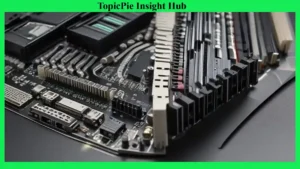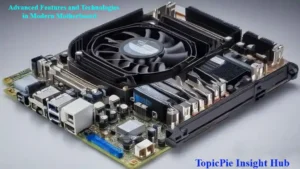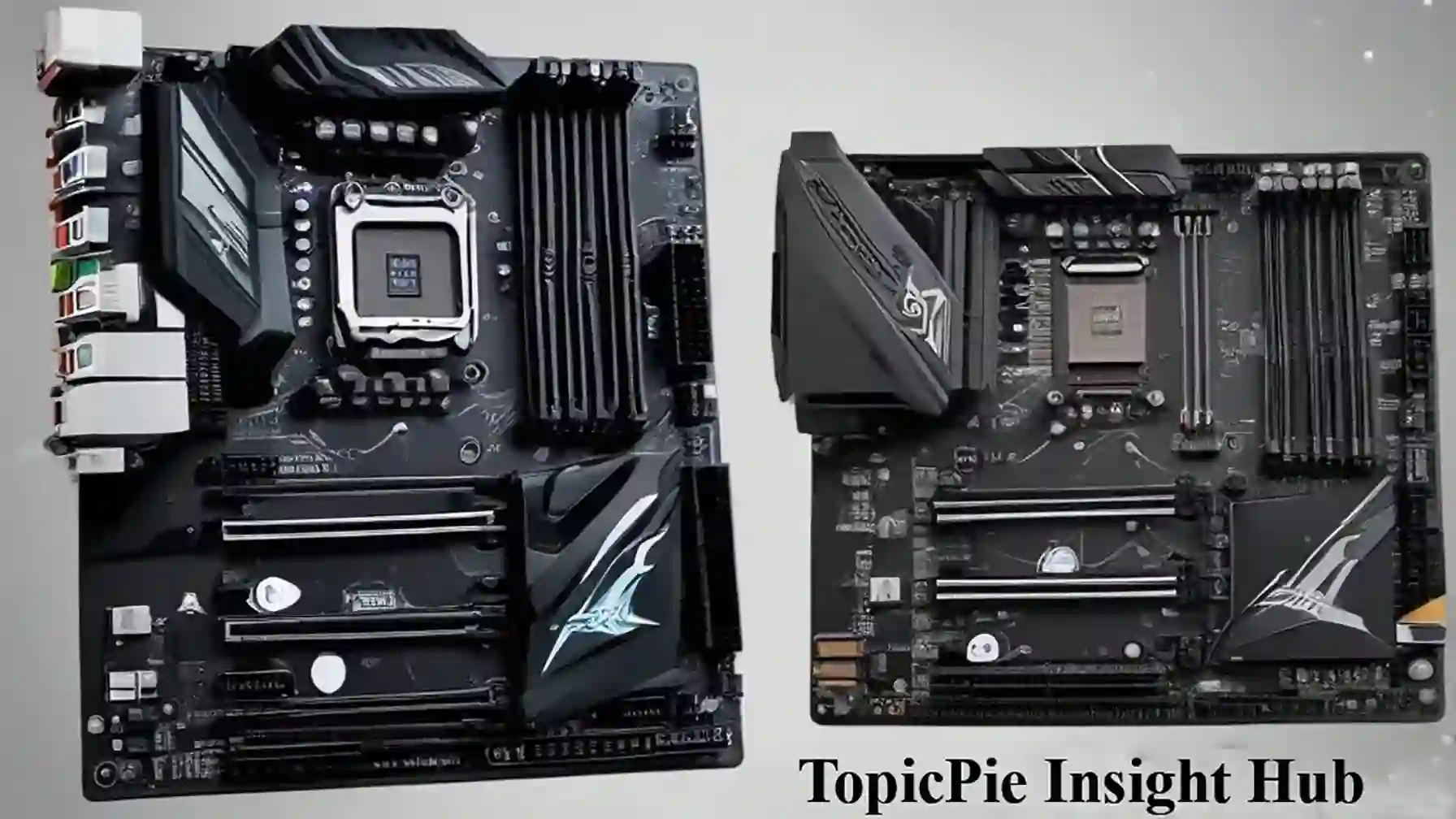Are you gearing up to build your dream PC? Well, then you’re in for an exciting ride! When it comes to assembling the perfect computer setup, choosing the right motherboard is like selecting the heart of your system. Just as a strong foundation is crucial for a building, a reliable and compatible motherboard is essential for ensuring optimal performance. So, let’s dive into everything you need to know about picking the perfect motherboard for your PC!
Motherboards are the unsung heroes of any computer setup, connecting all the vital components and ensuring seamless communication. To understand how to choose the right motherboard for your PC, it’s essential to delve into their intricacies.
The Evolution of Motherboard:
The history and evolution of motherboards trace back to the early days of computing when they were bulky and limited in functionality. In the 1980s, the first motherboards were simple, housing only the most essential components and offering minimal connectivity. Over the years, as technology advanced, so did the capabilities and designs of motherboards.
In the 1990s, motherboards began to integrate more functions directly onto the board, reducing the need for additional expansion cards. This era saw the inclusion of integrated graphics, sound, and networking capabilities. As processors became more powerful, motherboards evolved to support higher data transfer speeds and larger memory capacities.
Also Read: Firmware: Key to Understanding Your Device’s Performance | The Unsung Hero of Electronics
Today, modern motherboards boast advanced features and sleek designs that cater to various needs. From supporting multiple GPUs for gaming enthusiasts to providing extensive connectivity options for professionals, the evolution of motherboards has been remarkable. They now come with features like built-in Wi-Fi, advanced audio solutions, and sophisticated power management systems.
Key Factors to Consider When Choosing a Motherboard:
When selecting a motherboard, several factors play a pivotal role in ensuring you get the best performance and compatibility for your build. Here’s a detailed breakdown:
1. Form Factor
The form factor of a motherboard determines its size and shape, which in turn affects the type of case you’ll need. The most common form factors include:
- ATX (Advanced Technology eXtended): The most popular and standard size, offering the most features and expansion slots.
- Micro-ATX: Slightly smaller than ATX, with fewer expansion slots but still suitable for most users.
- Mini-ITX: A compact form factor ideal for small builds but limited in terms of expansion.
Choosing the right form factor depends on your space requirements and the components you plan to use. For example, if you aim to build a compact gaming PC, a Mini-ITX motherboard would be suitable. However, for a more versatile setup with multiple GPUs and expansion cards, an ATX motherboard would be better.
2. CPU Sockets
The CPU socket on the motherboard must be compatible with the processor you choose. The most common types of CPU sockets are:
- LGA (Land Grid Array): Used by Intel processors.
- AM4 and AM5: Used by AMD processors.
Ensure that the motherboard’s socket type matches the CPU you intend to use, as this will ensure compatibility and optimal performance. For instance, Intel’s latest processors use the LGA 1700 socket, while AMD’s new Ryzen series utilizes the AM5 socket.
3. Chipset
The chipset determines the motherboard’s capabilities and features. Different chipsets offer various levels of support for components and connectivity options. For example, high-end chipsets like Intel’s Z-series or AMD’s X-series provide more PCIe lanes, better overclocking support, and advanced features.
A chipset like the Intel Z790 offers enhanced memory support, more USB ports, and additional PCIe lanes compared to a B760 chipset. Similarly, AMD’s X670E chipset offers premium features compared to the B650.
4. RAM (Memory) Support
Motherboards have specific RAM slots (DIMM slots) and support certain types of memory (DDR4, DDR5). Consider the following:
- Maximum RAM Capacity: Ensure the motherboard can support the amount of RAM you plan to use.
- RAM Speed: Check the motherboard’s compatibility with high-speed memory modules.
- Dual-Channel or Quad-Channel Support: Depending on your needs, choose a motherboard that supports the desired memory configuration for optimal performance.
High-end motherboards might support up to 128GB or more of DDR5 RAM, offering enhanced performance for tasks like video editing and 3D rendering. Additionally, motherboards with advanced BIOS settings allow for fine-tuning memory timings and speeds.
5. Expansion Slots and Ports
Motherboards come with various expansion slots and ports for adding additional components:
- PCIe Slots: For GPUs, sound cards, and other expansion cards.
- M.2 Slots: For high-speed SSDs.
- USB Ports: Ensure there are enough USB ports for your peripherals.
- SATA Ports: For traditional hard drives and SSDs.
Consider the types and number of expansion slots and ports you need based on your planned setup. For instance, if you plan to use multiple GPUs, ensure the motherboard has enough PCIe x16 slots and supports multi-GPU configurations like NVIDIA SLI or AMD CrossFire.
6. Integrated Peripherals
Many modern motherboards come with integrated peripherals, such as:
- Audio: Built-in sound cards with varying quality levels.
- Networking: Onboard Ethernet and Wi-Fi options.
- Graphics: Some motherboards have integrated graphics, although these are generally less powerful than dedicated GPUs.
Choose a motherboard with the integrated peripherals that match your needs, or be prepared to add dedicated components. High-end motherboards often include premium audio solutions like the Realtek ALC1220 codec or better, offering superior sound quality for gaming and media consumption.
7. Temperature Management
Good temperature management is crucial for maintaining optimal performance and longevity of your components. Look for motherboards with:
- Heat Sinks: To dissipate heat from critical areas.
- Fan Headers: Sufficient headers for connecting multiple cooling fans.
- Advanced Cooling Solutions: Support for liquid cooling and other advanced cooling systems.
Some motherboards feature built-in fan control software, allowing for precise adjustments to fan speeds and ensuring optimal airflow. Additionally, premium motherboards often come with robust VRM cooling solutions to handle overclocked CPUs effectively.
8. Reliability and Warranty
Consider the brand reputation and the warranty offered. Reliable brands typically provide better build quality and support, which can be crucial in case of any issues. Brands like ASUS, MSI, Gigabyte, and ASRock are known for their quality and customer support.
A good warranty period can offer peace of mind. For example, some manufacturers provide up to a three-year warranty on their motherboards, covering defects and failures.

Choosing the Best Motherboard for Gaming:
For gaming enthusiasts looking to build a high-performance rig, certain tips can guide them towards selecting a motherboard optimized for gaming:
1. Multiple GPU Support
If you plan to use multiple GPUs (SLI or CrossFire), ensure the motherboard has sufficient PCIe slots and supports multi-GPU setups. This is crucial for maximizing graphics performance. Additionally, check if the motherboard supports PCIe 4.0 or PCIe 5.0 for the latest GPUs.
2. High-Speed Memory Support
Gaming often requires fast and responsive memory. Choose a motherboard that supports high-speed RAM and allows for easy overclocking. High-end gaming motherboards typically support memory speeds of 5000 MHz or higher.
3. Advanced Cooling Solutions
Gaming can generate significant heat, so opt for a motherboard with advanced cooling solutions, including multiple fan headers, support for liquid cooling, and efficient heat sinks. Some motherboards also feature thermal armor and enhanced heat pipe designs for better cooling efficiency.
4. Audio Quality
High-quality audio can enhance the gaming experience. Look for motherboards with built-in advanced audio solutions, such as dedicated sound cards or high-quality integrated audio chips like the Creative Sound Blaster series.
5. Connectivity Options
Ensure the motherboard has ample USB ports, including USB Type-C, for connecting gaming peripherals and accessories. Additionally, having built-in Wi-Fi and Ethernet options can provide flexible and reliable network connectivity. Wi-Fi 6E support is an excellent feature for future-proofing your build.
Motherboard: Comparing Top Brands and Models in 2024
In 2024, several motherboard brands and models stand out for their performance, reliability, and features. Here is a comparison of some of the top choices available:
1. ASUS ROG Strix Z790-E Gaming WiFi
- Chipset: Intel Z790
- Form Factor: ATX
- RAM Support: DDR5, up to 128GB
- Key Features: PCIe 5.0 support, advanced cooling solutions, RGB lighting, high-quality audio, and extensive connectivity options.
The ASUS ROG Strix Z790-E Gaming WiFi is designed for gamers who demand the best. It offers robust power delivery, excellent overclocking capabilities, and comprehensive connectivity, making it a top choice for high-end gaming rigs.
2. MSI MPG B650 Carbon WiFi
- Chipset: AMD B650
- Form Factor: ATX
- RAM Support: DDR5, up to 128GB
- Key Features: PCIe 5.0 support, enhanced power design, Wi-Fi 6E, multiple M.2 slots, and robust build quality.
The MSI MPG B650 Carbon WiFi is ideal for AMD enthusiasts. It combines high performance with great aesthetics, offering a balanced solution for gaming and productivity.
3. Gigabyte AORUS X570 Master
- Chipset: AMD X570
- Form Factor: ATX
- RAM Support: DDR4, up to 128GB
- Key Features: Advanced thermal design, multiple PCIe 4.0 slots, high-quality audio, extensive connectivity, and robust power delivery.
The Gigabyte AORUS X570 Master is known for its durability and performance. It features an advanced thermal design to keep your components cool under heavy load, making it suitable for overclocking enthusiasts.
4. ASRock Z790 Taichi
- Chipset: Intel Z790
- Form Factor: ATX
- RAM Support: DDR5, up to 128GB
- Key Features: 16-phase power design, multiple PCIe 5.0 slots, high-speed networking, premium build quality, and advanced cooling options.
ASRock’s Z790 Taichi is a premium motherboard offering excellent build quality and performance. It is equipped with features that cater to both gamers and professionals, ensuring a versatile and powerful platform.
5. EVGA Z690 Classified
- Chipset: Intel Z690
- Form Factor: ATX
- RAM Support: DDR5, up to 128GB
- Key Features: Robust power delivery, extensive PCIe 5.0 support, high-quality audio, and comprehensive cooling solutions.
The EVGA Z690 Classified is a high-end motherboard known for its stability and overclocking capabilities. It provides a solid foundation for building a powerful gaming or workstation PC.
Advanced Features and Technologies in Modern Motherboard:

Modern motherboards come with an array of advanced features and technologies that enhance performance, usability, and connectivity. Here are some notable ones:
1. PCIe 5.0
PCIe 5.0 offers double the bandwidth of PCIe 4.0, providing faster data transfer rates for GPUs, SSDs, and other peripherals. This makes it a crucial feature for future-proofing your build, especially for gamers and content creators who require high-speed data access.
2. Wi-Fi 6E
Wi-Fi 6E extends Wi-Fi 6 into the 6 GHz band, offering more bandwidth and less interference. This results in faster and more reliable wireless connections, which is beneficial for online gaming, streaming, and other data-intensive tasks.
3. Thunderbolt 4
Thunderbolt 4 provides high-speed data transfer, video output, and power delivery through a single cable. It supports up to 40 Gbps transfer speeds and can connect to a variety of devices, making it a versatile addition to modern motherboards.
Alao Read: Shining Brighter Than Ever: Exploring China’s Revolutionary Artificial Sun
4. USB 3.2 Gen 2×2
USB 3.2 Gen 2×2 offers up to 20 Gbps transfer speeds, significantly improving data transfer rates for external storage devices. This is particularly useful for professionals who work with large files, such as video editors and graphic designers.
5. RGB Lighting and Customization
Many modern motherboards feature RGB lighting and support for various customization options. With software control, users can sync the lighting with other components and peripherals, creating a cohesive and visually appealing setup.
The Importance of BIOS/UEFI in Motherboard Functionality:
The BIOS (Basic Input/Output System) or UEFI (Unified Extensible Firmware Interface) is a critical component of any motherboard, responsible for initializing hardware during the boot process and providing an interface for configuring system settings.
1. User-Friendly Interface
A user-friendly BIOS/UEFI interface can make a significant difference in the ease of setting up and configuring your system. Look for motherboards with intuitive interfaces that offer advanced features like one-click overclocking, fan control, and hardware monitoring.
2. Overclocking Support
For enthusiasts looking to push their hardware to the limit, robust overclocking support is essential. Modern motherboards often include features like AI overclocking, allowing users to optimize their CPU and memory performance with minimal effort.
3. Firmware Updates
Regular firmware updates can improve system stability, add new features, and enhance compatibility with new hardware. Choose a motherboard from a manufacturer known for providing frequent and reliable BIOS/UEFI updates.
Motherboard: Future-Proofing Your Build
When choosing a motherboard, it’s essential to consider not just your current needs but also future upgrades. Here are some tips for future-proofing your build:
1. Select a Modern Chipset
Choosing a motherboard with a modern chipset ensures support for the latest technologies and standards. This can include PCIe 5.0, DDR5 RAM, and advanced connectivity options like Wi-Fi 6E and Thunderbolt 4.
2. Opt for High RAM Capacity
Even if you don’t need a large amount of RAM now, opting for a motherboard that supports higher RAM capacities can be beneficial. This allows for future upgrades without the need to replace the motherboard.
3. Consider Expansion Slot Availability
Having extra PCIe slots and M.2 slots can accommodate future upgrades, such as additional GPUs, high-speed storage, or advanced networking cards. This flexibility can extend the lifespan of your build.
4. Check for Comprehensive Connectivity
Ensure the motherboard has ample USB ports, audio jacks, and networking options to accommodate new peripherals and devices as they become available.
Motherboard: Building and Assembling Your PC
Once you’ve chosen the perfect motherboard, the next step is building and assembling your PC. Below is a step-by-step guide to assist you through the process:
1. Prepare Your Workspace
Ensure you have a clean, static-free workspace. Gather all the necessary tools, such as screwdrivers, and organize your components.
2. Install the CPU
Carefully align the CPU with the motherboard socket and secure it in place. Apply thermal paste to the CPU before installing the cooler.
3. Mount the Motherboard
Place the motherboard into your case, aligning it with the standoff screws. Fasten the motherboard with screws to ensure it is securely and firmly in place.
4. Install RAM and Storage
Insert the RAM sticks into the DIMM slots, ensuring they click into place. Install your storage devices, such as SSDs and HDDs, connecting them to the appropriate ports.
5. Connect Power Supply
Connect the power supply cables to the motherboard, CPU, GPU, and other components. Please verify that all connections are securely fastened and properly inserted.
6. Install the GPU
Insert the GPU into the appropriate PCIe slot and secure it with screws. Attach the requisite power cables from the power supply to the GPU.
7. Connect Peripherals
Connect your peripherals, such as keyboard, mouse, and monitor, to the appropriate ports on the motherboard. Attach any additional components, such as case fans or liquid cooling systems.
8. Power On and Configure BIOS/UEFI
Power on your system and enter the BIOS/UEFI. Configure the settings according to your preferences, such as enabling XMP for memory overclocking or adjusting fan profiles.
Troubleshooting Common Issues for Motherboard:
Building a PC can sometimes come with challenges. Below are some typical problems and suggestions for resolving them:
1. System Won’t Power On
- Check all power connections to ensure they are securely connected.
- Verify that the power supply switch is turned on.
- Ensure the motherboard standoffs are not causing a short circuit.
2. No Display on Monitor
- Ensure the monitor is properly connected and powered on.
- Check if the GPU is correctly seated and connected to the power supply.
- Reset the BIOS/UEFI by clearing the CMOS.
3. Overheating Issues
- Verify that all cooling solutions are properly installed and functioning.
- Ensure good airflow within the case by organizing cables and installing additional fans if necessary.
- Reapply thermal paste if the CPU cooler is not seated correctly.
Conclusion
Selecting the appropriate motherboard is a crucial stage when constructing your ideal PC. By understanding the key factors to consider, such as form factor, CPU sockets, chipsets, RAM support, expansion slots, and integrated peripherals, you can make an informed decision that ensures optimal performance and compatibility for your system.
For gaming enthusiasts, additional considerations like multiple GPU support, high-speed memory, advanced cooling solutions, audio quality, and connectivity options are essential for creating a high-performance gaming rig.
You may also like to read: Advancements in Machine Learning Algorithms: What’s Next for AI Technology
With the top brands and models in 2024 offering a wide range of features and capabilities, you have plenty of options to choose from. By following expert tips and thoroughly planning your build, you can select the perfect motherboard that meets your needs and helps you achieve the ultimate computing experience.
Happy building!








